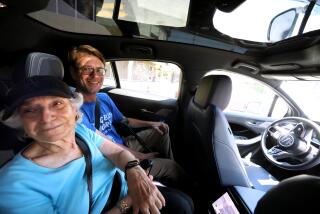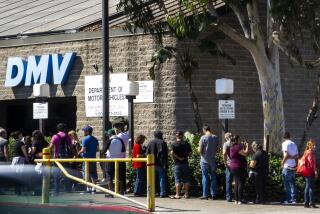Rallye Ho! Puzzled Drivers Hit the Road
- Share via
They can be more agonizing than asking for directions at a gas station, and even more horrible than discovering page 14 is missing from the Thomas Guide street directory.
Car rallyes, born on West Coast college campuses in the late 1950s, are not for the weak-wheeled.
Commonly called “brain teasers on wheels,” the rallyes (no one seems to know how the name became misspelled or exactly who originated the sport) challenge drivers to untangle double entendres and other language traps as they chart, for instance, a 20-mile course through residential streets in the San Fernando Valley.
The sport, which nearly became extinct in the mid-70s during the gas crisis, gradually regained popularity at a Sepulveda Dam site in the early ‘80s.
Now about 200 participants gather there one Saturday night each month to scour rules for hidden meanings before starting up engines. Participants pay $10 a car to enter, and can take up to four hours to complete the course, which is not run as a race. To avoid traffic jams, starting times are staggered, beginning at 7:30 p.m. Points are racked up by correctly answering questions on a control card.
“It’s an exercise in mental misdirection,” said Eugene Volokh, 21, a rallyemaster who has written several rallyes. “We try to convince you that things are different from what they seem. It makes you think in precise terms.”
For example, Volokh once told drivers, who were purchasing rallye novelties during registration, that “nothing will go on sale” after the start. The first instruction on the evening’s rule sheet was to “turn right as soon as possible,” which would have steered drivers onto Sale Avenue.
Rule sheets are rife with so many word traps that they force drivers to scrutinize directions much like lawyers dissect legal documents. Rallyemasters often pack as many as six traps into one rule which, in turn, can produce as many as 17 answers, sending cars in a hodgepodge of directions.
But entrants seldom get lost. Each potential misdirection has a built-in “loop,” sending drivers back on course.
“Sometimes people are satisfied when they catch one trap, so they won’t look for a more complex, hidden one,” said Larry Scholnick, a 20-year rallye veteran who lives in Sherman Oaks. “We try to trick them into believing a more difficult trap doesn’t exist.”
“This is not something that only geniuses would do,” said Volokh, who graduated from UCLA with a degree in math and computer science at 15. “It’s for everyone. It requires a love of puzzles, but it’s not a contest between great minds.”
But the 12 or so rallyemasters (there isn’t an official count or organized group) who write the rules do appear to possess microchip minds. Volokh lives in the Hollywood Hills, where he writes software programs. Scholnick, 37, works as a systems analyst in Santa Monica.
To aspire to the rank of master, entrants must pass through five categories of difficulties, “trophying,” or winning, two to four times in each category before eventually graduating to the title of rallyemaster.
At a recent rallye, about 175 entrants queued up to register and receive instructions at the Sepulveda Dam parking lot. Nearly 100 cars and vans were parked, many containing teen-agers, families and couples hunched over rules with flashlights, searching for traps. Nearby, about 30 first-timers, who entered the beginner’s course, pulled wool jackets and ski parkas tighter as Bill Armstrong, a rallye assistant, explained the rules.
“I see some quizzical looks out there. Are you still with me?” the Pasadena rallye veteran asked.
Other participants huddled around a blue Honda Accord, its hood laden with boxes of trophies destined for winners from the previous month’s rallye.
Along the course, car map lights flicked on as navigators and back-seat drivers pored over directives, shouting first “Turn right!” then “Turn left!” and finally, “Back up!”
Others got out of cars, either to escape arguments that fogged up windshields or to get a better look at street signs. Some complained that spending money to get lost in Reseda after enduring rush-hour traffic was not their idea of a fun Saturday night.
“It’s really interesting,” said Allison Gates, a first-time participant who lives in Pacoima. “No matter how well you have it figured out, you suspect you have to think it through a little further.”
Gates, 35, who was traveling with a friend, added: “We definitely are having some differences of opinion in the car. I wanted to stop at each intersection along a certain stretch to check them against the rules, but my friend said, ‘There’s no way I’m going to stop the car and do that!’
“We’re still friends now, but I can see where some people wouldn’t be.”
Drivers entered two checkpoints set up along the route where more rules were handed out. Traps were uncovered, which had little to do with driving or the route itself. “Because of inclement weather, if it begins to pour, please turn on your windshield wipers,” one rule stated. Rallye workers served hot chocolate at the checkpoint as some drivers remembered to turn on their wipers as the steaming liquid was poured, while others were distracted by the welcome sight of something hot to drink on a chilly night.
Traps can become doubly difficult as participants sort out an order of precedence within the instructions: Directives from the rallyemaster must be heeded over rules received at checkpoints. Other rules and instructions are even further down. If items conflict, entrants must obey the higher precedence. The final tallies are judged by the course rallyemaster.
Drivers and navigators gathered at a Granada Hills Round Table Pizza after the rallye to socialize and compare control cards.
“I get a high and a sense of satisfaction, figuring out when someone is trying to fool me,” said James Watkins, 46, who lives in Sylmar and works as a television repairman.
“I would absolutely do it again,” said Watkins’ navigator, psychotherapist Susan Adler, 49, of Tarzana. “I do crossword puzzles every day. I like the fact that you always have to be thinking.”
When designing a course, rallyemasters first consult the Thomas Guide to search for neighborhoods. Streets often are chosen for names that conveniently mesh with a theme. But almost any location will do.
One rallye centered around a “Moonlighting” TV series theme. Drivers were told that each time they saw Willis, they should consider it Addison (Bruce Willis starred in the series as David Addison). Upon arriving at the intersection of Willis Avenue and Addison Street in Van Nuys, drivers were asked to name the junction which had become Addison/Addison and could no longer be considered an intersection. A previous rule had stated that intersections must consist of two differently named streets.
Rallyemasters spend up to 300 hours creating rallyes, a process that includes a dry run of the course and a double-check of complicated loop systems by other rallyemasters.
The monthly events turn only a slim profit, said Scholnick, adding that overhead costs like trophies, classified advertisements and a 4,000-member mailing list pare down earnings. Charities, such as Childrens Hospital in Los Angeles, sometimes benefit from the rallyes.
What do neighbors think of a fleet of cars descending on their quiet, suburban neighborhoods?
“We did have an incident a couple years ago where cars had to turn around in a dead end,” said Scholnick, who added police are tolerant of the rallyes that instruct drivers to always obey the vehicle code. “One woman got real upset about all the traffic so she put up a fake checkpoint sign. She went up to the car windows and asked for passengers’ rallye instructions. And then she crumpled them up.”
Bullwinkle Says, ‘Turn Left at Oxnard’
An excerpt from a recent car rallye with a “Bullwinkle” theme:
Left at OXNARD and then left at LASAINE.
What is the name of the Xth RDWY you come to on your right? To determine X, use the following: -------------- = X + Y - Z.
X = the zip code for Frostbite Falls, Minn., minus the phone extension of the Whatsa Matta U football coach.
Y = X minus 1.
Z = 2 times Y.
While you are puzzling over Q3, the narrator says: A gust of wind blows the Kurward Derby into your car and onto Bullwinkle’s head. The Derby turns the wearer into the smartest person in the world. Bullwinkle correctly tells you, “The capital city of Bulgaria is named Sophia; 56789 is the zip code for Frostbite Falls, Minn.; the speed of light is 299,792 km/sec, and the Whatsa Matta U football coach’s extension is 56787.” Unfortunately for you, another gust of wind blows the Derby away, and Bullwinkle reverts to his normal, not too intelligent self.
More to Read
Sign up for Essential California
The most important California stories and recommendations in your inbox every morning.
You may occasionally receive promotional content from the Los Angeles Times.










